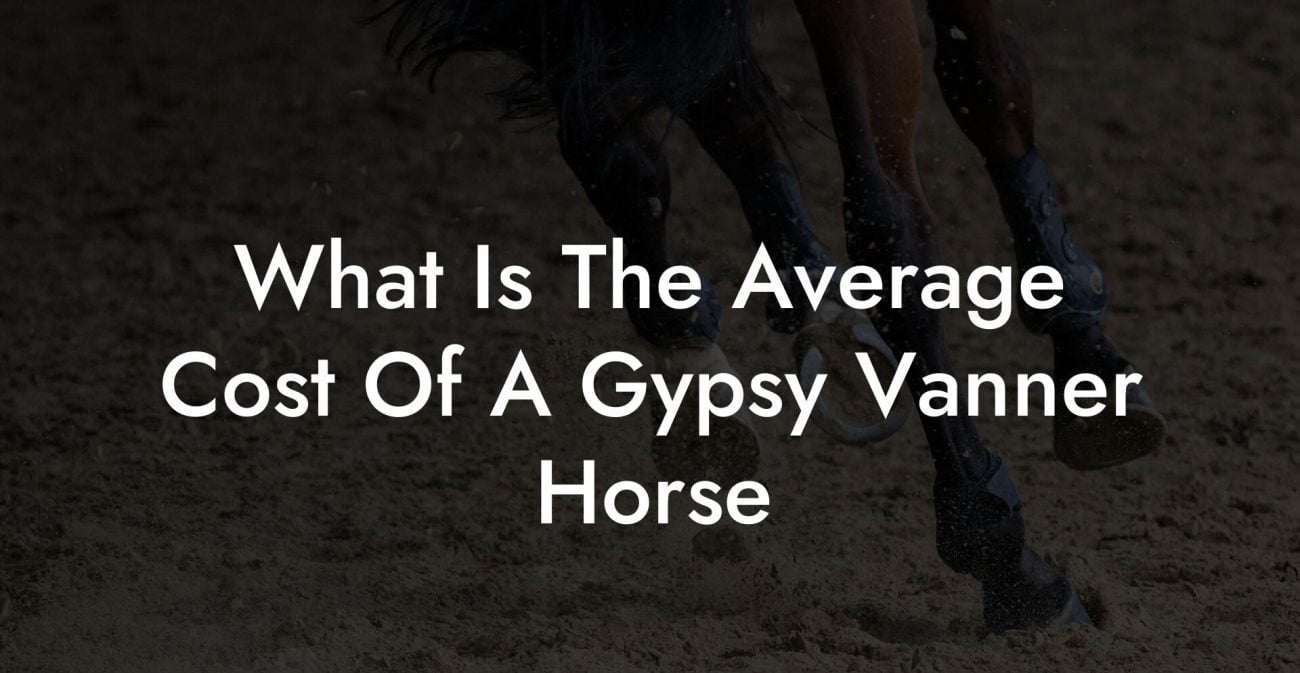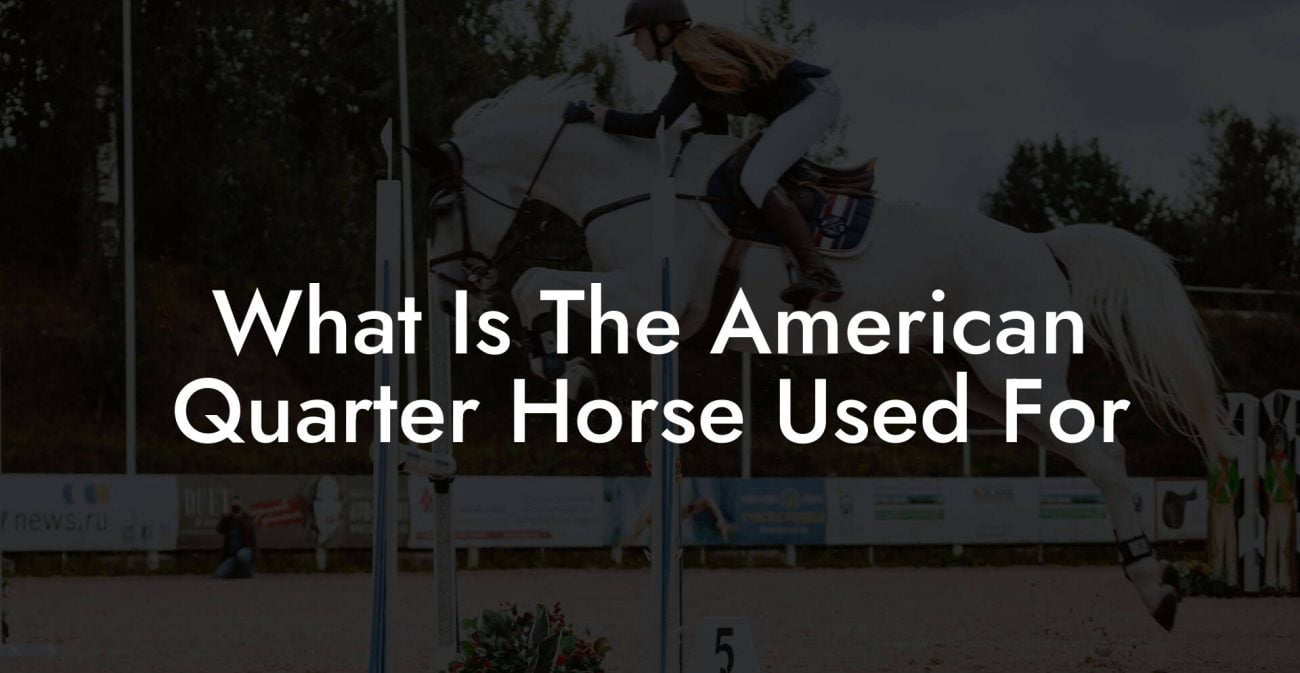Ever wondered how a seemingly old-school move in football got its name, and what it has to do with the noble art of caring for a living, breathing horse? Buckle up (or should we say saddle up) as we gallop through the intriguing world of the "horse collar" in football, a play that not only changed the dynamics on the field but also serendipitously lends its name to some timeless lessons in horse care. Whether you're a die-hard NFL fanatic, a casual viewer, or someone who spends weekends grooming their equine companion, this in-depth guide is your ultimate ride into a world where athletic tactics meet horse whispering.
Quick Links to Useful Sections
- The Origins of the Horse Collar in Football
- Understanding the Horse Collar Tackle: Mechanics and Philosophy
- Rules, Regulation, and the Modern Game
- The Horse Collar: Bridging the Worlds of Football and Equine Care
- A Closer Look at Horse Care: Lessons We Can Learn from Football
- Evolution of the Horse Collar Tackle: From Controversy to Change
- Impact on the Game: Changing Perspectives and Strategies
- How the NFL’s Horse Collar Ban Shapes Player Behavior
- Integrating Technology in Rule Enforcement and Player Safety
- Insights from the Field: Stories from Players and Horse Owners
- Football Players Speak Out
- Equine Care Wisdom
- Resources and Community Support: Your Next Steps
- Best Practices for Caring for Your Horse: Practical Tips
- 1. Gear Up Correctly
- 2. Consistent Grooming and Health Checks
- 3. Balanced nutrition and Hydration
- 4. Mindful Handling and Training
- Combining Passion with Knowledge: Empowering Your Journey
- FAQ: Your Questions on the Horse Collar in Football and Related Equine Care Answered
- Your Roadmap to Mastery: Embrace the Best of Both Worlds
The Origins of the Horse Collar in Football
At first blush, "horse collar" might conjure images of rustic tack and rugged farm life. But in football, the term takes on a whole new meaning. The "horse collar tackle" is a controversial move that has sparked endless debates, rule changes, and passionate discussions among players, coaches, and fans alike. Its origins date back to the evolution of football tactics, where a defender would grab the back collar of a ball carrier’s shoulder pads (or, mythically speaking, the collar of a horse) and pull them down violently, often leading to injury.
While the move may seem straightforward, its impact, both on player safety and on the fairness of the game, was profound. As football became more aggressive and the risk of severe injuries grew, the NFL eventually banned this move in an effort to protect their athletes. Interestingly, the term "horse collar" is not just a football term but also a nod to the equipment used in horse care. In equestrian settings, a horse collar is a padded piece of equipment that fits around a horse’s neck and shoulders, allowing it to pull a load efficiently and comfortably. The connection? Both contexts emphasize proper technique and safety to prevent injury, whether to a player or a horse.
Today, the horse collar tackle serves as a cautionary tale in football, reminding us that even moves steeped in tradition must evolve with changing priorities in safety and sportsmanship. And for those who care for horses, it’s a reminder of the incredible balance between power and protection.
Understanding the Horse Collar Tackle: Mechanics and Philosophy
Let’s break it down: the horse collar tackle in football was once considered a legitimate defensive technique. Essentially, the defender would seize the back of the ball carrier’s shoulder pads, much like one might grab the collar of a horse, and yank them down unexpectedly. While this might have worked in the rough and tumble days of early football, it soon became clear that the move could cause serious spinal injuries and knee damage.
In the spirit of modern safety protocols, the NFL and other leagues have outlawed this tackle, deeming it a flagrant violation of the rules. The philosophy behind the change is simple: if you’re going to exert force, whether on the field or while pulling a plow with your horse, it should be done in a way that doesn’t injure the subject of that force.
For players and coaches, understanding the mechanics of the horse collar tackle is essential. Not only does it underscore the evolution of in-game strategy, but it also prompts a broader discussion on how technique and innovation should always prioritize the well-being of the person (or horse) involved. It's a classic case of why the best moves are the ones that respect the body's natural structure.
Rules, Regulation, and the Modern Game
In football, rules are the framework that ensures fair play and, most importantly, player safety. The horse collar tackle became notorious for the dangers it posed. The NFL, after numerous injuries and outcry from both players and fans, moved swiftly to disallow the move. Modern rules penalize it harshly, with fines and on-field penalties designed to deter defenders from using the technique.
Rule changes in football often come with heated debates and even more heated locker room discussions. Coaches argue over the fine line between a good defensive play and an illegal maneuver. Players recount personal injuries sustained from such tackles, and analysts break down each incident with surgical precision on sports networks. The horse collar, as a concept, has effectively become a rallying cry for enhanced safety protocols across all levels of the game.
It’s worth noting that these regulatory efforts are driven by a common goal: ensuring the game remains as safe as possible for everyone involved. Just as equestrians meticulously check their horse’s tack for any wear and tear before a ride, football leagues inspect and update their rules to ensure no player is compromised on the field.
The Horse Collar: Bridging the Worlds of Football and Equine Care
At this point, you might be thinking, “What does a touchdown rule have to do with caring for a horse?” The answer lies in the shared theme of safety and care in both worlds. In football, the outlawed horse collar tackle is all about the dangers of poor technique and excessive force. In the equine world, using the proper horse collar is not only about ensuring a horse can pull its load efficiently but also about preventing injury and discomfort.
Considering the welfare of an animal requires a similar sense of responsibility to that of protecting a player. Just as football coaches train their star defenders to avoid illegal moves, horse owners are taught to inspect and maintain tack to keep their prized steeds comfortable and healthy. It’s all about using the right tools, in the right way, at the right time.
So, whether you’re sideline watching the game while questioning a risky play, or you’re out in the barn figuring out the best collar for your horse, the underlying message remains the same: care, precision, and respect matter, whether on the gridiron or at the stable.
A Closer Look at Horse Care: Lessons We Can Learn from Football
For the equestrians and horse enthusiasts among you, delving into the history and evolution of the horse collar in football offers valuable lessons in care and technique. When you gear up to care for your horse, you’re not just dressing an animal, you’re partnering with a living being that relies on you for comfort and support.
Here are some key parallels to consider:
- Proper Fit Is Key: Just like the NFL has strict standards to ensure that players’ equipment is safe and compliant, a well-fitted horse collar ensures that your horse does not suffer from friction or chafing. Whether it’s the padding or the design, the goal is to provide comfort while maintaining functionality.
- Regular Maintenance: Football teams conduct routine equipment checks, and as a horse owner, regular inspections of your horse’s tack (including the collar) thwart potential issues before they injure your companion. Replace worn-out straps and ensure that buckles and rings are secure.
- Technique Makes a Difference: In football, technique can prevent dangerous plays like the horse collar tackle. Similarly, proper training and handling techniques in horse care can prevent common injuries. Whether it’s during grooming, loading onto a trailer, or even during riding, a gentle, informed approach makes all the difference.
- Safety First: The NFL’s reaction to the horse collar tackle teaches us that safety must always trump performance. For horse lovers, safety measures, from the design of the tack to the expertise of the handler, are equally paramount. A safe horse is a happy horse.
These insights serve as a reminder that whether you’re managing game-day play or everyday equine care, the principles of respect, precision, and adaptability are universal.
Evolution of the Horse Collar Tackle: From Controversy to Change
The journey of the horse collar tackle from an accepted move to a banned maneuver is one marked by controversy, reflection, and ultimately, progress. It all started when the move began to dominate the defensive playbook, leading to several high-profile injuries that raised critical questions about player safety.
As the football community began to recognize the drop in player well-being associated with the move, pressure mounted on league officials to act. Critics argued that the technique, while once a clever exploitation of loose rules, had outgrown its welcome. The reformed rules were meant not to stifle dynamism but rather to protect players, ensuring that the game could be both thrilling and safe.
Beyond the rule book changes, the cultural shift around the move altered how fans and players perceive aggressiveness and fairness. In a way, this evolution reflects broader societal changes over the past few decades, the growing emphasis on health, sustainability, and ethical practices. Just as sports have had to modernize their strategies to remain relevant and safe, so too have many traditional practices in fields as diverse as farming, animal care, and even technology.
The lesson here transcends the gridiron: it’s a call for continuous improvement and conscientious innovation. Whether revamping the rules in sports or updating the gear in your horse’s stable, improvement is the only constant.
Impact on the Game: Changing Perspectives and Strategies
Since the horse collar tackle was banned, coaches, players, and fans have recalibrated their strategies to embrace safer yet equally effective defensive techniques. The evolution of these strategies has not only raised the bar on player safety but has also enhanced the overall spectacle of the game.
Modern defenses now focus on smart positioning, leveraging agility and technique rather than brute force. Teams study film rigorously, breaking down the biomechanics of successful tackles that avoid high-risk moves. There’s been a cultural shift toward valuing technique over dangerous physicality, a move that has reshaped the identity of football as a whole.
Moreover, the changes have sparked thoughtful debate among fans and pundits. What does it mean to win in a game where safety reigns supreme? How do you balance the raw energy of football with the inevitable need for caution? These questions have permeated discussions in sports talk shows, social media threads, and even coaching clinics.
And while some critics mourn the loss of what they once viewed as a "tough" move, the prevailing consensus acknowledges that the advancement of safety protocols elevates the game. In essence, football’s evolution mirrors that of any dynamic field, it must adapt, innovate, and sometimes let go of older, riskier traditions in favor of practices that protect its future.
How the NFL’s Horse Collar Ban Shapes Player Behavior
With the horse collar tackle off-limits, player behavior on the field has had to adjust dramatically. Today's defensive plays require nuance and precise timing rather than reliance on brute force. Coaches now emphasize the importance of staying on one’s feet, reading the play, and reacting with agility.
This shift in strategy has a ripple effect throughout the team dynamic. Players train harder to perfect techniques that ensure they remain within the boundaries of the rules while still disrupting offensive movement. This has led to a broader adoption of advanced training methods, including video analysis and biomechanical assessments.
From a safety perspective, players are less likely to suffer the catastrophic injuries that once haunted the league. The NFL’s commitment to protecting its athletes continues to drive innovation in coaching, training, and even equipment design. It’s a shining example of how a sport can evolve to better serve the needs of its participants without sacrificing the excitement and unpredictability that fans adore.
For young athletes looking to make their mark, the lessons are clear: mastering technique, staying informed about rule changes, and embracing a mindset that values both performance and safety are crucial. It’s a blueprint not just for football, but for any field where passion meets responsibility.
Integrating Technology in Rule Enforcement and Player Safety
In today’s digital era, technology plays a pivotal role in how rules are enforced and how player safety is monitored. The horse collar tackle ban has catalyzed the development of sophisticated technologies, ranging from high-speed cameras to wearable sensors, that help detect illegal moves and assess their impact in real time.
Referees are now armed with instant replays and cutting-edge monitoring systems that allow them to make more informed decisions on the field. These technological enhancements contribute to a fairer game and are a testament to football’s commitment to athlete safety.
What’s more, many teams incorporate technology into their training programs. Wearable devices track player movement, enabling coaches to tailor training sessions that minimize injury risks and refine tackling techniques. These breakthroughs underscore a critical point: protective measures, whether on the field or in horse stables, are only as effective as the systems designed to implement them.
For tech-savvy Gen Z and millennial fans, the integration of technology in football signals a convergence of innovation and tradition. It’s about embracing the best of both worlds: the old-school grit of the sport and the new-school smart strategies that keep it evolving. And if you’re into high-tech horse care gadgets that monitor your horse’s health, you’ll appreciate how digital innovations are transforming age-old practices for the better.
Insights from the Field: Stories from Players and Horse Owners
Nothing encapsulates the lessons learned from the horse collar debate quite like firsthand accounts. Across the football world, players have shared stories of how modifying their playing style not only reduced injuries but also led to surprising improvements in their overall performance. On the flip side, seasoned horse owners reveal how meticulously maintained tack and a commitment to gentle, informed handling have transformed their equine partnerships.
Football Players Speak Out
Take, for instance, the story of a veteran linebacker who, after sustaining a harsh blow from an illegal horse collar tackle, became an outspoken advocate for the rule change. His experience serves as a stark reminder that the health of players should never be compromised for the sake of aggression. His journey from injury to recovery, underscored by a shift in defensive strategy, resonates with many players finding innovative, safer ways to excel in the sport.
Equine Care Wisdom
On the other side of the field, there’s Maria, an avid horse enthusiast who transformed her approach to horse care after a local farrier introduced her to the benefits of modern horse collars. Maria learned that a well-designed collar, much like a properly executed play, can make all the difference in preventing injury and ensuring longevity. Her dedication to continuous improvement, whether through investing in advanced tack or pursuing the latest equine training methods, mirrors the same evolution seen in the NFL.
These stories, whether from the gridiron or the stable, remind us that evolution is the natural order of things. Embracing change, be it a safety rule or upgraded horse tack, can lead to outcomes that are better for individuals and communities alike.
Resources and Community Support: Your Next Steps
Ready to dive deeper into the world of football rules and equine care? The passion for improving safety and performance extends far beyond the confines of the field and barn. There’s a vibrant community of athletes, coaches, horse enthusiasts, and tech innovators all sharing insights, troubleshooting challenges, and celebrating victories, both on game day and at the stable.
Here are some valuable resources to kickstart your journey:
- Online Forums and Social Media Groups: Engage with communities on platforms like Reddit, Facebook, and Twitter. Whether you’re discussing the latest NFL safety protocols or seeking tips on horse tack maintenance, these groups are treasure troves of shared knowledge and real-world advice.
- Workshops and Webinars: Numerous organizations and experts offer virtual workshops on player safety, advanced football techniques, and modern equine care. Keep an eye on event calendars from respected institutions like the NFL, equine veterinarians, and horse care associations.
- Local Clubs and Associations: Consider joining your local football fan club or equestrian society. These groups often host in-person events, clinics, and community meet-ups, providing a blend of hands-on learning and networking opportunities.
- Tech Innovations in Safety and Equipment: Stay updated on technological advancements that impact both football and horse care. From wearable sensors for player health to smart tack that monitors a horse’s well-being, these gadgets are revolutionizing traditional practices.
Building a support network that bridges your interests in sports and horse care can open new avenues for learning and growth. It’s about leveraging community expertise to raise the bar for both personal performance and the well-being of your equine companions.
Best Practices for Caring for Your Horse: Practical Tips
Whether you’re a seasoned rider or a newbie, the principles behind proper horse care remain timeless. Here’s a roundup of practical tips that echo the lessons we’ve discussed:
1. Gear Up Correctly
The right equipment is the foundation of both athlete safety and equine care. Invest in a well-fitted, padded horse collar that supports your horse’s natural movements. Regularly inspect the tack for signs of wear and replace any components that could cause discomfort or injury.
2. Consistent Grooming and Health Checks
Much like regular training and evaluation in football, routine grooming and veterinary check-ups are essential for your horse’s health. Daily grooming not only keeps your horse comfortable but also helps you spot early signs of skin irritation or injury.
3. Balanced nutrition and Hydration
A nutritious diet tailored to your horse’s needs is crucial for long-term health. Feed your horse high-quality forage complemented by the necessary vitamins and minerals, and ensure they stay well-hydrated, especially during active days.
4. Mindful Handling and Training
Whether you’re teaching your horse new commands or training for advanced performance, consistency, gentleness, and understanding are key. A calm horse is less prone to stress-related injuries, a sentiment that resonates with the emphasis on safety in football.
As you integrate these best practices, remember that the goal is a harmonious partnership with your horse, where both performance and well-being are nurtured with equal care.
Combining Passion with Knowledge: Empowering Your Journey
The intertwined narratives of football safety and horse care illustrate a fascinating synergy: knowledge empowers better practices, and better practices lead to improved outcomes. Whether you’re on the field strategizing your next move or in the stable bonding with your horse, being well-informed is the ultimate power play.
For Gen Z and millennial enthusiasts, leveraging both tradition and technology is the way forward. Embrace online learning platforms, participate in YouTube tutorials, and engage with communities that respect both innovation and history. Your journey toward excellence, be it in sports strategy or equine care, is paved with curiosity and the courage to question the status quo.
Every rule change, every upgraded piece of tack, and every safety protocol is a reminder that the best systems are those that grow and evolve with us. As you continue to explore, share, and learn, you join a global community dedicated to improvement, innovation, and care for all living beings, both on the field and in the pasture.
FAQ: Your Questions on the Horse Collar in Football and Related Equine Care Answered
Here are some of the most frequently asked questions that shed light on the controversial move in football and draw parallels with practical horse care advice:
1. What exactly is a horse collar tackle?
The horse collar tackle is a move where a defender grabs the back collar of the offensive player’s shoulder pads (reminiscent of grabbing a horse’s collar) and pulls them down violently. It has been banned in professional football due to the high risk of injury it poses.
2. Why was the horse collar tackle banned in football?
The move was banned because it often resulted in serious injuries such as neck, spinal, and knee damage. The NFL and other leagues revised their rules to protect players by discouraging excessively forceful tackles.
3. Can understanding the horse collar tackle improve my knowledge of player safety?
Absolutely. The evolution of the horse collar tackle underscores the importance of technique, respect for one’s body, and continuous improvement in safety protocols, lessons that translate well into other fields, including equine care.
4. How is a horse collar used in equine care?
In the realm of horse care, a well-designed horse collar is essential for distributing weight evenly when a horse is pulling a load. It helps prevent injuries, ensures comfort, and promotes efficiency, much like safety equipment in football.
5. What maintenance tips should I follow for horse tack?
Regular inspection, proper cleaning, timely replacement of worn-out parts, and ensuring a correct fit are key. Just as players need proper gear that meets safety standards, horses thrive when their tack is well-cared for.
6. Are there modern technologies to monitor player and horse safety?
Yes, technology plays a huge role in both football and equine care. From wearable sensors on athletes and horses to smart gear that tracks usage, continuous advancements help ensure safety and improve performance.
7. How do community resources contribute to better practices in football and horse care?
Engaging with supportive communities, whether in sports clubs or equestrian groups, helps individuals share knowledge, keep updated on best practices, and innovate together, leading to safer and more effective methods on and off the field.
Your Roadmap to Mastery: Embrace the Best of Both Worlds
The exploration of the "horse collar" in football offers more than just an understanding of a banned tactic, it provides a gateway into broader lessons about safety, innovation, and care. The convergence of football strategy and equine management reminds us that every field, from sports to stable, thrives on precision, responsibility, and a never-ending quest for improvement.
As you reflect on the evolution of rules that once allowed the dangerous horse collar tackle, think about how those changes parallel the modern approaches in horse care that prioritize comfort and health. Whether you’re a fan, a player, or a devoted horse owner, the underlying principles remain clear: respect, responsibility, and continuous learning are the foundations for success.
Stay curious, keep exploring new techniques, and use every resource at your disposal, be it high-tech training tools, trusted community advice, or tried-and-true horse care practices. Your journey towards mastery in any field is enriched by an openness to change and a deep commitment to doing things safely and effectively.
So, as you gear up for your next football game analysis or prepare for a hands-on session in the stable, remember that the best outcomes are achieved when we blend tradition with innovation. Step into the future of safety, performance, and care with confidence and enthusiasm, because in sports and in life, evolution is the ultimate victory.













